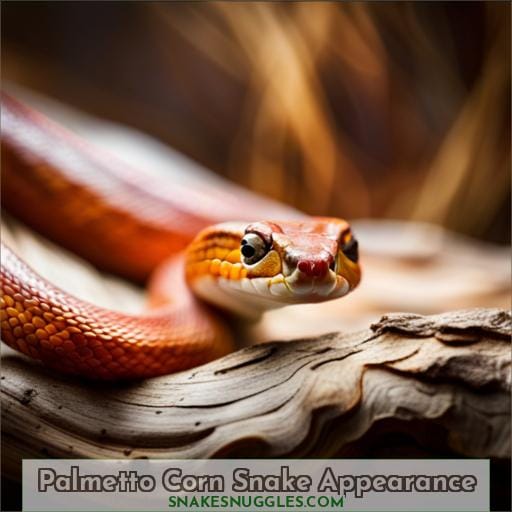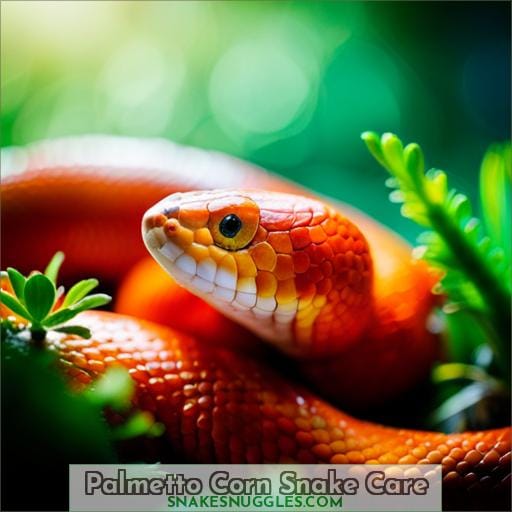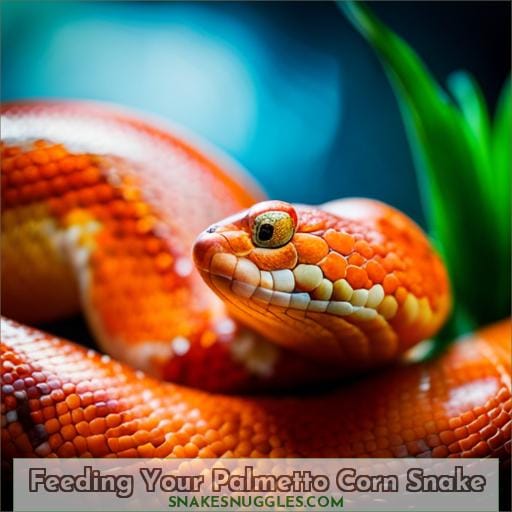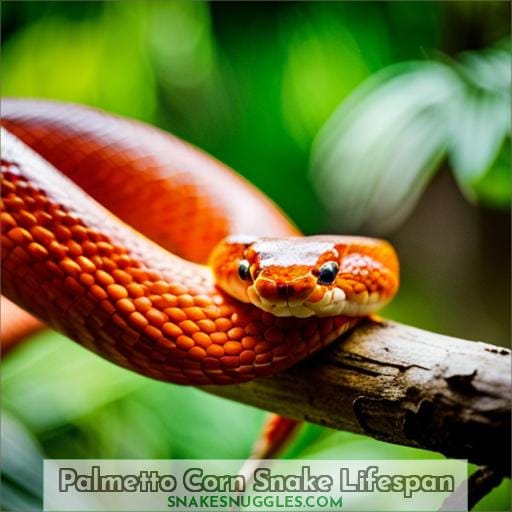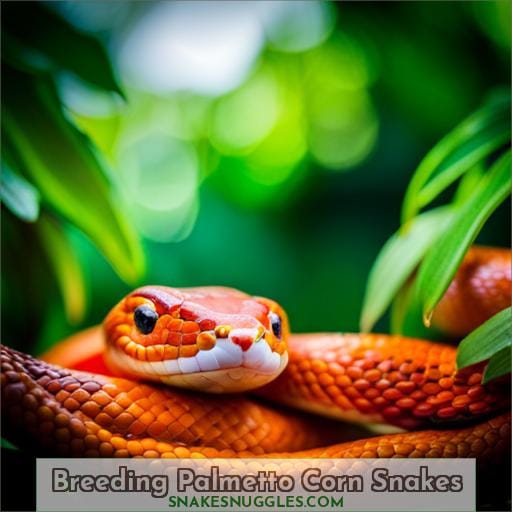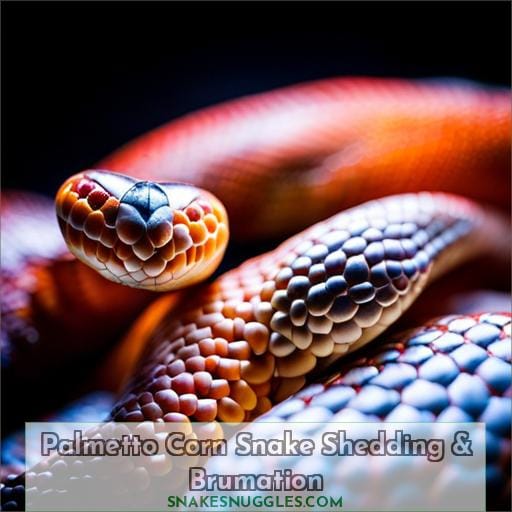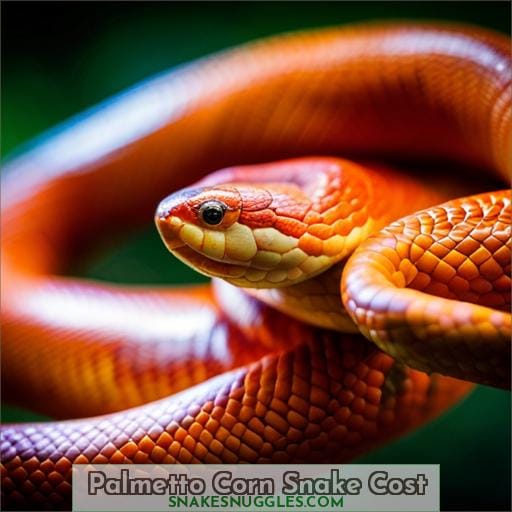This site is supported by our readers. We may earn a commission, at no cost to you, if you purchase through links.
 Like a snake charmer, this guide will mesmerize you with essential details for properly caring for the uniquely patterned palmetto corn snake.
Like a snake charmer, this guide will mesmerize you with essential details for properly caring for the uniquely patterned palmetto corn snake.
As their caretaker, understand critical husbandry tips to provide a healthy home that meets their fundamental needs for heating, humidity, feeding, and disease prevention.
Achieve success and satisfaction in raising content palmettos by applying the focused snake python knowledge in this easy-to-follow reference.
Table Of Contents
- Key Takeaways
- Quick Facts About Palmetto Corn Snake
- Palmetto Corn Snake Appearance
- Palmetto Corn Snake Care
- Feeding Your Palmetto Corn Snake
- Keeping Your Palmetto Corn Snake Healthy
- Palmetto Corn Snake Lifespan
- Breeding Palmetto Corn Snakes
- Are Palmetto Corn Snakes Friendly Pets?
- Palmetto Corn Snake Shedding & Brumation
- Palmetto Corn Snake Cost
- Frequently Asked Questions (FAQs)
- What kind of enclosure is best for a baby palmetto corn snake?
- How can I tell if my palmetto corn snake is stressed or unhappy?
- What are signs that my palmetto corn snake may be sick and need a vet visit?
- Where can I buy a healthy palmetto corn snake?
- Can I handle my palmetto corn snake every day or will that stress it out?
- Conclusion
Key Takeaways
Quick Facts About Palmetto Corn Snake
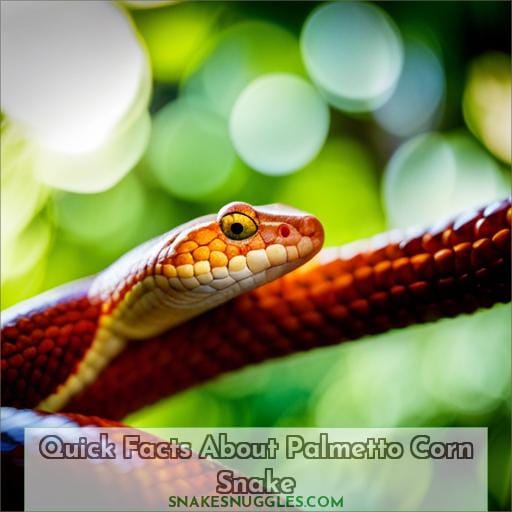
Its scientific name is Pantherophis guttatus. You’d know this unique corn snake by its pinkish body with barely visible dots as a juvenile, transforming into a vibrant white adult covered in black and red spots that can grow over 5 feet long.
As babies, palmetto corn snakes need an environment between 75-85°F to thrive, with humidity around 40-50%. Handling them frequently from a young age will lead to a docile, friendly adult snake.
These heavy-bodied snakes can eat adult mice or small rats every 5-7 days once fully grown. Their genetic variations from classic corn snakes result in slightly different habitat preferences, requiring a minimum 20-gallon tank with places to hide and climb.
Conservation efforts aim to responsibly breed these snakes while preserving genetic diversity.
Palmetto Corn Snake Appearance
You’ll notice the Palmetto’s pinkish color with barely visible dots as a juvenile before it transitions to a vibrant white adult with distinct black and red spots.
- Pinkish with dots as juveniles
- Vibrant white with black and red spots as adults
Genetic Mutations:
- Specifically bred for unique look
Breeding Patterns:
- Relatively easy to breed in captivity
Morphological Traits:
- Grows up to 5 feet long
- As thick as a paper towel roll
The Palmetto was originally captured in South Carolina in 2008 as the only known wild Palmetto in captivity at the time. It has been specifically bred for its unique coloration and patterns, resulting in the vibrant pink, white, black, and red adult snakes seen today.
Though relatively easy to breed in captivity, the Palmetto remains distinguishable from other corn snakes.
Palmetto Corn Snake Care
When caring for your Palmetto corn snake, you’ll need to set up an appropriate enclosure with proper heating, humidity, and substrate.
An enclosure at least 20 gallons in size with a secure lid is recommended, as these snakes can escape easily.
Provide a temperature gradient with a warm side around 85°F and a cooler area around 75°F to allow your snake to properly thermoregulate.
Tank
The minimum tank size you’ll need is 20 gallons, with a long and shallow shape preferred to allow your snake ample room to move around.
Provide a secure lid, as corn snakes can be escape artists.
Decor should include hiding places and climbing branches.
Good tank setup helps meet the needs of a healthy, happy palmetto corn snake.
| Tank Size | 20+ gallons |
|---|---|
| Lid | Secure, escape-proof |
| Decor | Hiding places, branches |
| Ventilation | Good airflow |
Heating
For proper heat, you’re going to want an under tank heater on one side that keeps the warm end at 80-85°F while allowing a cool end down to 75°F.
Use a thermostat to regulate temperatures.
Position heat sources to create a thermal gradient inside the enclosure for your corn snake.
Monitor temperatures daily and make adjustments as needed.
Proper heating and regulation enables healthy shedding, feeding, and activity levels.
Humidity
When caring for your Palmetto corn snake, maintaining proper humidity levels in its enclosure involves monitoring and adjusting as needed to keep ideal conditions.
Use a hygrometer to track the humidity, which should be 40-60%.
Adjust using misting, ventilation, and substrate moisture.
In drier months, mist more often and restrict ventilation.
In more humid months, mist less and increase ventilation.
Proper humidity supports skin shedding and prevents respiratory infections.
Substrate
Pick an appropriate loose substrate like aspen shavings or cypress mulch for your Palmetto corn snake’s enclosure.
Aspen absorbs moisture well, while cypress mulch helps maintain humidity. Both allow snakes to burrow while avoiding impaction risk.
Newspaper also works, but doesn’t look natural. Sani-chips control odor and humidity effectively too.
Ensure at least one hide contains substrate that holds some moisture to aid shedding.
Feeding Your Palmetto Corn Snake
You should feed your adult Palmetto corn snake one mouse per week.
It’s important to establish a regular feeding schedule for your pet snake to ensure its health and well-being.
When selecting the appropriate rodent size, choose mice that are roughly the same width as your snake’s body or slightly larger.
Frozen/thawed rodents are recommended as they eliminate the risk of live prey injuring your snake during feeding time.
Thawing techniques involve placing the frozen rodent in warm water until it reaches room temperature, ensuring that it’s safe for consumption by your Palmetto corn snake.
While mice form their primary diet, you can also consider alternate diets such as fuzzy rats or even small birds on occasion to provide some variety and enrichment for your reptile companion.
Keeping Your Palmetto Corn Snake Healthy
When caring for your Palmetto corn snake, you must monitor its health and watch for issues like mouth rot or fungal infections.
Provide clean water at all times since these snakes tend to soak in their water dishes, which can aid in shedding and prevent stuck shed skin.
Also keep the enclosure clean and double check that temperatures and humidity levels are in the proper range to prevent health problems.
Mouth Rot
A telltale sign of mouth rot in your Palmetto corn snake is cheesy deposits in the mouth.
This condition, caused by cryptosporidium serpentis or cryptosporidium saurophilum, requires treatment with medications prescribed by a veterinarian.
- Keeping the enclosure clean
- Monitoring humidity levels
- Checking your snake’s health routinely
Early intervention gives the best chance for full recovery from symptoms like:
- Jaw swelling
- Bad breath
- Listlessness in your pet elaphe guttata
Fungal Disease
A fungal infection in your palmetto corn snake requires prompt veterinary attention to clear up.
Fungal diseases like scale rot stem from unsanitary environments. Prevent with proper husbandry.
Vets diagnose through skin scrapings and cultures then prescribe topical or oral anti-fungals.
Also treat the vivarium with fungicides to prevent reinfection.
Quarantine infected snakes until the infection resolves.
Palmetto Corn Snake Lifespan
Moving on from keeping your Palmetto corn snake healthy, let’s discuss their lifespan.
Your Palmetto can live 6 to 23 years with proper care. Their genetics and environment impact longevity.
Consider these factors:
- Genetics – Purebred Palmettos often outlive mixed-breeds.
- Regular handling – Palmettos that get frequent gentle handling tend to live longer.
- Clean enclosure – Change water and clean cage regularly to prevent disease.
- Balanced diet – Feed appropriate frozen/thawed rodents to meet nutritional needs.
- Climate control – Maintain proper temperatures and humidity levels.
With attentive care catered to their needs, your Palmetto can remain a slithering family member for up to two decades!
Now let’s explore breeding these unique snakes.
Breeding Palmetto Corn Snakes
Prior to pairing them up for mating, you’ll need to properly condition a male and female Palmetto corn snake.
Cool the snakes down to 60-65°F for 2 months to simulate winter brumation.
Gradually warm them back up over 2 weeks, misting the enclosure to boost humidity.
Offer extra food as temperatures rise to spark breeding interest.
Once the female starts shed cycles, introduce the male.
If receptive, she’ll lift her tail and gape her cloaca.
Allow multiple matings then separate them.
The female will lay about a dozen eggs 30 days post-breeding.
Incubate at 85°F.
Hatchlings exhibit amazing Color Genetics like amelanism and hypomelanism when bred with Morph Variations.
The rare appearances command high Market Trends among collectors.
Meticulous Breeding Strategies preserve the uniqueness of Palmetto Genetics in captive bloodlines.
Are Palmetto Corn Snakes Friendly Pets?
Having covered how to breed Palmetto corn snakes, you may wonder if they make good pets.
Consider the following about their temperament:
- Palmettos become accustomed to handling when worked with consistently. Regular gentle interaction prevents defensive behaviors.
- Despite their shyness, Palmettos rarely bite. Their calm demeanor suits dedicated owners.
- Reward-based training encourages engagement. Food rewards for approaching you streamlines handling.
Palmettos require an attentive yet patient owner to become relaxed and confident around people. Once trust develops through careful handling techniques, these striking snakes transform into docile companions.
Now let’s discuss shedding and brumation habits.
Palmetto Corn Snake Shedding & Brumation
Palmetto corn snakes undergo a natural cycle that includes brumation and shedding their skin annually.
- Shedding occurs every 4 to 6 weeks, aiding growth and removing external parasites.
- Brumation, similar to hibernation, happens in the winter, slowing metabolism and reducing activity for 2 to 3 months. Proper brumation is crucial for health and breeding.
| Stage | Shedding | Brumation |
|---|---|---|
| Early | Skin dulls/opaque | Decreased appetite |
| Mid | Skin detaches in patches | Rarely emerges from hides |
| Late | Shed fully in 1 piece | Minimal movements |
| End | Skin vibrant again | Appetite and activity return |
Palmetto Corn Snake Cost
After shedding and brumation, you’ll be wondering how much it costs to bring home your own Palmetto corn snake.
As with any snake, pricing depends on factors like age, sex, color, and rarity.
On average, a normal-colored hatchling runs $50-100 from a breeder.
However, the unique coloration and scarcity of Palmettos commands higher pricing.
Morphs with bright whites or vivid spotting can fetch over $500, especially females.
Though tempered by ethical considerations around price gouging, the market sustains these premiums due to rare variants and collector demand.
While lower maintenance than many exotic pets, proper Palmetto care requires an investment in habitat materials.
For most owners, enjoyment of their pet’s coloration and docile nature is return enough on their initial investment potential.
As with any enthusiast community, it helps check market trends against breeder pricing to find the sweet spot between quality and affordability.
Frequently Asked Questions (FAQs)
What kind of enclosure is best for a baby palmetto corn snake?
Provide a 10-gallon or larger terrarium.
Use aspen shavings or Sanichips as substrate.
Include hiding spaces, branches, and a secure lid to prevent escape.
Maintain proper temperature and humidity.
Clean the enclosure weekly.
How can I tell if my palmetto corn snake is stressed or unhappy?
Hiding more than usual,
Moving erratically when handled,
Reddish brown belly,
Hissing,
Tightly coiled body,
Refusal to eat regularly,
Lethargy,
And visible weight loss.
Provide a proper habitat and gentle, minimal handling to avoid these stress signals.
What are signs that my palmetto corn snake may be sick and need a vet visit?
- Lack of appetite
- Lethargy
- Unusual breathing
- Wheezing or discharge from nose/mouth
- Abnormal feces
- Weight loss
- Retained eye caps
- Abscesses
- Injuries
- Parasite infestation (mites)
Regularly monitoring health and quickly addressing concerning symptoms is crucial.
Where can I buy a healthy palmetto corn snake?
You can purchase healthy palmetto corn snakes from reputable breeders online or at reptile expos.
Always inspect snakes before buying and ask about their health history.
Select an active snake with clear eyes, intact scales, and no signs of illness.
Can I handle my palmetto corn snake every day or will that stress it out?
You can handle your palmetto corn snake daily in short sessions.
Limit handling to 10-15 minutes per session, as too much continuous contact may distress the snake.
Gentle, regular interaction helps build trust between snake and owner.
Conclusion
When it comes to our scaly friends, few captivate quite like the palmetto corn snake.
[Keypoints]With proper caretaking:
- An appropriately sized habitat
- Consistent feeding
- Attention to humidity
You’ll charm yourself a content companion.
As long as you:
- Avoid common pitfalls like mouth rot
- Employ necessary husbandry
- Give your slithering serpent lots of handling
You and your palmetto will live happily ever after.

